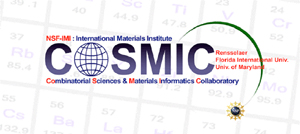News Story
Rubloff, Takeuchi are co-PIs for NSF International Materials Institute

The Combinatorial Sciences and Materials Informatics Collaboratory (CoSMIC) is being funded by a five-year, $3.5 million grant to the University of Maryland, Rensselaer Polytechnic Institute (lead institution), and Florida International University. Nearly half the award comes to Maryland.
CoSMIC will develop leading-edge experimental and information-based tools for high-speed discovery and evolution of new materials and processes. Its research focus is combinatorial experimentation and materials informatics, systematic approaches that represent a profound qualitative change in how materials R&D can be practiced. Combinatorial methods enable rapid experimentation and analysis by generating and analyzing large numbers of material combinations in parallel. Informatics methods include databases, multiscale modeling structures, and systems for data management and visualization to enable efficient usage by practitioners.
CoSMIC’s major research areas include: Informatics, Modeling, and Databases, led by Krishna Rajan (RPI); Combinatorial Experimentation, led by Takeuchi; Education and Research Integration, led Rubloff; and IT Infrastructure and Collaboration, led by Surendra Saxena (FIU).
About the Maryland PIs
Rubloff is an expert in materials processing and control for semiconductor manufacturing. He is pursuing novel equipment design paradigms for combinatorial chemical vapor deposition with Associate Professor Ray Adomaitis (ChE/ISR) in the Laboratory for Advanced materials Processing (LAMP). Rubloff’s simulation research is also the driver for the simulation-based learning environments (through the Center for Engineered Learning Systems and the Human-Computer Interaction Laboratory), which will be the centerpiece of CoSMIC’s educational outreach activities.
Rubloff says, “Systems methodologies such as modeling, databases, and virtual design, with targeted advances in experimental capability, are a critical asset in meeting the rapidly growing materials challenges we see in nanotechnology, biotechnology, and the continuing advancement of microelectronics to support information technology.”
Takeuchi is an internationally recognized leader in combinatorial methods. Leading the Center for Combinatorial Materials Synthesis, he has made significant contributions in magnetic and oxide materials, with implications for microelectronics, superconductivity, data storage, and microelectromechanical systems, and in the process his research has advanced combinatorial methods for materials science. He is heavily involved in international collaboration and professional activities in combinatorial materials science.
Takeuchi observes that “Combinatorial experimentation has the potential to revolutionize materials science, enabling new insights into fundamental physics, accelerating R&D, and stimulating innovation in processing and characterization.”
PIs outside of Maryland
Professor Krishna Rajan at Rensselaer Polytechnic Institute is a materials scientist and electron microscopist who has become a protagonist for materials informatics and combinatorial approaches that promise to dramatically enhance the tedious process of traditional materials fabrication and assessment.
“We want to do for materials science what The Human Genome Project did for biotechnology,” he says.
Professor Surendra Saxena at Florida International University is an expert in materials phase diagrams and high temperature materials, areas which are particularly attractive testbeds for informatics approaches. Examples of the work planned in the Institute include developing the next generation of ultra high temperature materials for more efficient and cleaner engines; designing new magnetic materials for ultra high density information storage applications, and new processing pathways for multifunctional materials used in sensors and microelectronic devices.
More on CoSMIC
The CoSMIC-IMI also represents a new way of conducting academic research. “Through global collaboration, universities can take advantage of the best instrumentation, the best minds, the best students. With our international partners it is now possible to accelerate the process of materials discovery and design on behalf of all participants in the international materials community," says Rajan. Using the INTERNET2 system, CoSMIC-IMI will connect a consortium of laboratories from ten countries across Europe, Japan, the Middle East, South America, Canada, and the United States. These laboratories are world leaders in materials theory and modeling, materials science databases high throughput experimentation techniques and combinatorial materials synthesis and processing.. The CoSMIC-IMI will also be aided by participation of numerous government laboratories, industries, professional societies and international agencies in the U.S. and abroad.
International education and outreach are an important aim of the IMI, which will establish a web-based portal to support the training of a new scientific workforce well versed in CoSMIC’s integration of materials and information sciences. The portal will serve as an international research and educational center for developing and sharing methodology, tools, and specific data and applications, significantly accelerating the discovery of new materials and processes for integration into engineering applications.
CoSMIC is one of three institutes established under NSF’s new IMI program within the Division of Materials Research.
Published June 15, 2004









